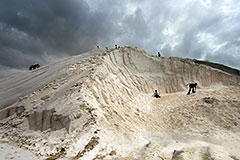          |
|
|
Tainan Tainan is the birthplace of Taiwan and the oldest city on the island. In 1661, the Ming loyalist Cheng Cheng-kung drove the Dutch from Taiwan and established his administration in Tainan. At the time, mainland Chinese immigrants were coming to Taiwan in droves, helping the young city to grow. After the Qing pacification of Taiwan in 1683, the Taiwan Prefectural Capital was established in Tainan. In 1885, Taiwan became a province and Tainan's position changed to that of Tainan Prefectural Capital, from which its current name derives. Tainan remained the political, economic and cultural center of Taiwan up to the late nineteenth century. As a result, Tainan is home to many famous historic sites. It also is the city with the longest history and earliest cultural roots in Taiwan. In addition to its historic and cultural attractions, Tainan boasts a stunning natural landscape and well-known agricultural and fishery products and cuisine. In spring, the Taiwan International Orchid Show is held in Houbi Township's Taiwan Orchid Plantation, presenting the early spring orchids in all their beauty and charm. Every year on the 15th day of the first lunar month, the spectacular Yanshui Beehive Rockets Festival attracts throngs of visitors from across Taiwan and the world to Tainan. And for an educational family fun in the summer visitors can choose from firefly watching in Meiling, lotus watching in Baihe, and activities at Qigu Mangrove Tourist Park. With the arrival of the autumn cool, visitors can head to Dongshan to sample the fragrant locally-grown Arabica coffee. And in winter, you can sooth away those sore muscles at the Guanziling mud springs.  Tainan Confucius Temple
Tainan Confucius TempleThe Confucius Temple in Tainan was built in 1666, it was the first Confucius Temple, before the end of Manchu Dynasty, it was the location of the highest official institute of higher learning in Taiwan. The Taiwan Palace of "Confucianism Study", it owned the incompatible position of culture and education, and was called "The Highest Institute". The Confucius Temple has been through more than thirty times of reconstruction, a part of the building was destroyed during the wars or ruined by nature disasters; the present scale of the Confucius Temple was the look after reconstructing during the time when Japanese were ruling (1917), its elegant and simple localization characteristic takes a distinctive attitude of its own among the Confucius Temples buildings in Taiwan. There are fifteen structures inside the Confucius Temple, the primary sacrifices in the palace is to Confucius divine tablet, on both sides, the sacrifices are to the sixteen pupils of Confucius.1  Anping Fort
Anping FortIn 1624, Dutch built the first fort in Anping, Taiwan, called "Fort Zeelandia", now known as Anping Fort, where has been the administrative center of the Dutch regime, and the hub for trading. The building was originally constructed in square inner fortress and rectangle outer walls. In 1661, the fort was renamed as Anping to commemorate his home town when Guoxingye (Cheng Cheng-Kung) has driven the Dutch out of Taiwan. Therefore, Fort Zeelandia was also known as "King's Fort" or "Taiwan Fort", nicknamed Anping Fort. The remaining more than 70 meters long south walls of the outer fort with worn-out red bricks, accompanied by the old banyan roots, chanted its odyssey. The fort is the very historical replica over three hundred years.2  Hai-an Road, Art Street
Hai-an Road, Art StreetThe Haian Rd. Art Street is situated within the Old Five Channels Cultural Zone. A group of artists transformed the street using art and injected new vitality into the area. Art is seen everywhere on the street, in the form landscape, painting and photography, permeating the locale with rich artistic ambiance. Many photography enthusiasts and visitors come here to appreciate art and take pictures.3 Black-faced Spoonbill Reserve Black-faced Spoonbill is one almost extinct bird in the world and protected by regulation. In 2003, Bird-Watching Association counts out almost one hundred Black-faced Spoonbills flying from the northeast area of Korea or Mainland China on every Oct. to stay in the mouth of Qigu Cengwen River for winter over. Because Black-faced Spoonbill is rarer than Panda and almost would fly to the mouth of Qigu Cengwen River, Black-faced Spoonbill has become the most famous bird in Taiwan.  Black-faced Spoonbill would fly here on every Sep. and Oct. and leave on next Mar. to May, thus this period is the best to watch Black-faced Spoonbill in Qigu. Because Black-faced Spoonbill usually take rest in the daytime and forage at night, they would gather together without any action but play, bathe, or clean feathers for each other at 4:00 or 5:00 pm.4  Qigu Salt Mountains
Qigu Salt MountainsThe Qigu Salt Field was once the largest solar salt field in Taiwan supplying salt for the domestic agricultural and industrial sector. Through changes in time, solar salt was no longer economically viable, hence the Qigu Salt Field ceased production in May 2002, marking the end of 338 years of solar salt history in Taiwan and the dawning of an era of recreation at the Qigu Salt Mountain. The Qigu Salt Mountain occupies an area of one hectare, and its white salt mountain peak is approximately six stories tall, making it a spectacle to behold. Through the fusion of tradition and innovation, Taiyen has infused the salt industry's history, culture & creative and health concept to present the diverse development of the salt industry. With unique salt theme tourist attractions such as the salt mountain's main peak, salt sculpture exhibition hall, solar salt experience area, salt house, antique machinery exhibition area and road train etc., the educational entertainment activities have transformed the park into a renowned sightseeing destination among international and domestic travelers.
1content & image source: http://eng.taiwan.net.tw/m1.aspx?sNo=0002119&id=78
2content & image source: http://eng.taiwan.net.tw/m1.aspx?sNo=0002119&id=147 3content & image source: http://www.twtainan.net/en-us/Attractions/Detail/2282/Hai-an-Road-Art-Street 4content & image source: http://eng.taiwan.net.tw/m1.aspx?sNo=0002119&id=5475 5content & image source: http://eng.taiwan.net.tw/m1.aspx?sNo=0002119&id=5474 |